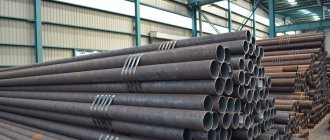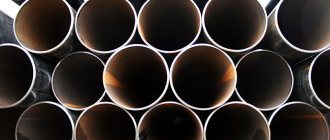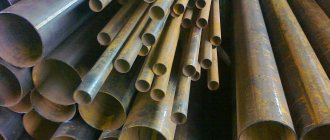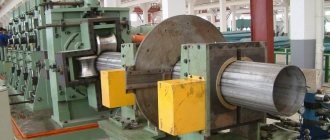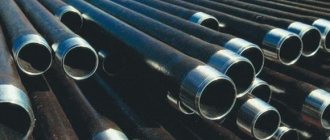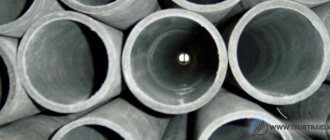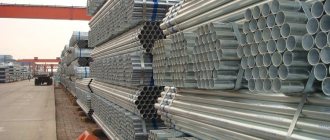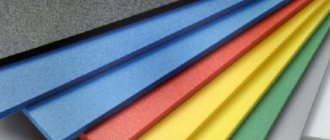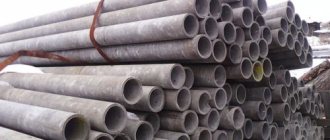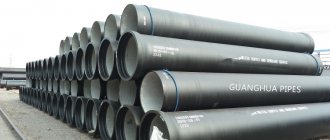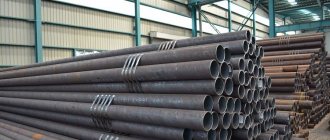Hot-rolled seamless steel pipes are the most common format, successfully used in all economic sectors. These products are known for the greatest reliability, especially for laying communications for various purposes. Most often, hot-deformed seamless steel pipe GOST 8732-78 is used in the construction of monolithic-frame structures, where reliability is paramount under such impressive loads.
Seamless steel pipes have practically no competitors in terms of resistance to high loads
General characteristics and basic information about solid pipes
Seamless hot-rolled pipes of standardization 8732 are produced from steel billets of the main grades:
- 10th, 20th, 35th and 45th standard;
- 35V;
- 40G and 45G;
- 15X and 40X;
- 9X1;
- 20PV;
- 30ХГСА;
- 17G1S,
- 09G2S;
- 10-20DDD.
Hot-deformed seamless pipes are produced in the form of:
- thick-walled products;
- thin-walled products;
- standard products.
These products are in demand and are widely produced by domestic and foreign enterprises. Hot-deformed pipes are made from steel billets and are produced by rolling heated raw materials using specialized factory equipment. Under other conditions, it is impossible to comply with all GOST requirements.
Seamless pipe production technology makes it possible to produce particularly thick-walled products
Good to know! The absence of a longitudinal welding joint is an important visual sign of the assortment of seamless steel pipes GOST 8732-78.
State standardization remains a guarantee of the reliability of seamless pipes, confirming control over key quality indicators. These include:
- absence of flattening, sagging and bends inside the walls;
- high impact resistance of pipes.
At manufacturing enterprises, metal quality control is periodically carried out and the chemical composition of the alloys used is confirmed. At the moment, seamless (w/w) pipe products are produced in two ways:
- cold-deformed seamless pipes;
- seamless hot-deformed steel pipes GOST 8732-78.
Taking into account the wishes of wholesale customers, chamfers and threads are applied to the cut edges of finished products. Sections are also processed - from one end or from both sides. It is worth clarifying all these conditions for product release with the company’s managers before placing an order.
As a rule, a batch of steel pipes GOST 8732-78 is shipped from enterprise warehouses directly to the customer. Warehouses do not always have finished products in the required volume. The cost of pipes varies periodically, depending on steel grades, so all aspects are discussed in advance with the sales departments. Product length varies from 4.5m to 11.9m. It is recommended to check the available assortment with managers.
The ends of the pipes can be untreated or chamfered
The difference between cold-deformed and hot-deformed pipes
Seamless pipes can be cold-formed or hot-formed. Both types are able to withstand high operating loads. The difference between the products lies in the production mechanism:
- Cold-deformed products are made by rolling on pipe-stitching machines from raw materials, which most often are profiled pipes that have already been hot-processed.
- Hot-deformed pipes are produced from billets in the form of a cylinder-shaped pipe, which changes its shape under the influence of heat treatment.
The external difference of seamless pipes is expressed in the absence of a longitudinal joining seam, which determines the smoothness of the internal walls, the absence of sagging and roughness, and, as a result, increased impact resistance and tightness.
Note! Hot-deformed pipes are more fragile than cold-deformed pipes, but they are less susceptible to rust.
What is important to know about standardization of seamless products?
Seamless pipe walls are produced according to GOST only in the specified thickness:
- 2.5, 2.8, 3, 3.5 mm;
- 4, 4.5, 5, 5.5 mm;
- 6, 7, 8, 9 mm;
- 10, 11, 12 mm;
- 14, 16, 17, 18 mm;
- 20, 22, 25, 28 mm;
- 30, 32, 36, 40, 45 mm;
- 50, 56 mm;
- 60, 63 mm,
- 70, 75 mm.
All domestic enterprises producing thick-walled and conventional used pipes are guided by the requirements of several standards:
- GOST 8732-70;
- GOST 8731-74;
- GOST 9567-75;
- GOST 8732-78;
- TU 82-70.
The permissible length of hot-deformed pipes is invariably regulated by the state standard:
- measured and unmeasured length of products (allowed from 4m to 12.5m);
- a multiple of the measured length of products (allowed within unmeasured lengths, plus an allowance for each cut of no more than 5 mm).
Note ! If the pipe length is ordered approximately, then the standards vary in the format of unmeasured length. The preparation time for the required batch of seamless standard pipes varies from two to four weeks, but it all depends on the volume of the order. The minimum batch of used hot-rolled steel pipes according to GOST 8732-78 should be about 3 tons.
According to GOST, the minimum batch of pipes must be at least three tons
The ratio of the wall thickness and the outer diameter of the hot-rolled pipe determines the rating:
- thin-walled used products;
- especially thin-walled;
- thick-walled used products;
- especially thick-walled.
The last two varieties are subjected to heat treatment so that the products receive additional resistance to pressure inside communications and main pipelines.
Seamless pipes are produced in a certain diameter:
- 20, 21.3, 22, 25, 26.9 and 28 mm;
- 30, 31.8, 32, 33, 35 and 38 mm;
- 40, 42, 42.4, 44.5, 45 and 48.mm;
- 50, 51, 54 and 5mm;
- 60, 60.3, 63.5 and 68 mm;
- 70, 73 and 76 mm;
- 82.5, 83, 89 and 95 mm;
- 102, 104, 108 and 114 mm;
- 121, 127, 133, 140 and 146 mm;
- 152, 159, 165 and 168 mm;
- 178, 180 and 194 mm;
- 203, 219, 245, 273 and 299 mm;
- 324, 325, 351, 356 and 377 mm;
- 402, 406, 426, 450, 457, 465 and 480 mm;
- 500, 508 and 530 mm.
Reference! The revised domestic standardizations GOST R 53383-2009, GOST 8732 (78 and 70) offer a new level of quality for seamless products that corresponds to products manufactured according to international standardization.
Today, a range of seamless products continues to be produced according to previously adopted GOST standards - 8732-78 and 8731-74. And in 2010, a national standard for products GOST R 53383-2009 was adopted, regulated by compliance with the requirements of TU 82-70.
According to GOST 8732-70, seamless steel pipes have an impressive weight, which is indicated in the standardization table. This especially applies to thick-walled products. Each grade of heavy metal differs in chemical composition, processing ductility and degree of strength, such as seamless pipes of the “70” or “78” standard. To some extent, this also affects the quality of thin-walled products, but a thick-walled solid pipe is guaranteed to be durable.
Cold-deformed seamless steel pipes
The estimated weight of one meter, the standard range of outer diameters/wall thicknesses and the accuracy class for cold-formed seamless steel pipes are established by the GOCT 8734-75 assortment. The technical conditions and grades of steel from which the pipes are made are regulated by GOCT 8733-74. Requirements for labeling, packaging, storage, acceptance and logistics are determined according to GOCT 10692-80.
Technical specifications according to GOCT 8733-74
Similar to the specifications for hot-formed pipes, cold-formed pipes are also divided into five groups, depending on the supply requirements:
- Group B: supply requirements are determined by standardization of chemical composition; pipes of this group are made from steel grades according to GOCT 1928, 14959, 4543, 1050.
- Group B: mechanical characteristics are standardized, steel grades are used according to GOCT 1928, 14959, 4543, 1050.
- Group D: mechanical characteristics are standardized (laboratory tests are carried out on heat-treated samples). For group G, steel grades according to GOCT 1928, 14959, 4543, 1050 are used.
- Group D: the values of the maximum hydraulic pressure are regulated, the mechanical parameters and chemical composition are not standardized.
- Group E: this group includes cold-deformed pipes that have undergone special heat treatment.
Range, accuracy class and weight of cold-deformed seamless pipes according to GOCT 8734-75
According to the assortment, cold-deformed pipes can be of the following sizes:
- the minimum possible outer diameter is 5 mm, the maximum is 250 mm;
- The minimum possible wall thickness is 0.3 mm, the maximum is 24 mm.
Pipes are divided into four categories, depending on the ratio of the outer diameter to the wall thickness: extra-thin-walled, thin-walled, extra-thick-walled and thick-walled.
GOCT 8734-75, weight per linear meter of cold-deformed pipes
| Outer diameter, mm | Wall thickness, mm | Weight 1 m, kg | Number of m in 1 t | Outer diameter, mm | Wall thickness, mm | Weight 1 m, kg | Number of m in 1 t |
| 10 | 1 | 0,220 | 4504 | 83 | 6 | 11,394 | 87,8 |
| 16 | 2 | 0,691 | 1447 | 100 | 7 | 16,055 | 62,3 |
| 20 | 2 | 0,888 | 1126 | 110 | 7 | 17,781 | 56,3 |
| 25 | 4 | 2,072 | 483 | 120 | 7 | 19,507 | 51,3 |
| 30 | 4 | 2,565 | 390 | 130 | 7 | 21,233 | 47,1 |
| 34 | 5 | 3,576 | 280 | 140 | 7 | 22,960 | 43,5 |
| 40 | 4 | 3,551 | 282 | 150 | 7 | 24,686 | 40,5 |
| 45 | 5 | 4,932 | 203 | 160 | 7 | 26,412 | 37,7 |
| 57 | 4 | 5,228 | 191 | 170 | 7 | 28,139 | 35,5 |
| 60 | 3 | 4,217 | 237 | 180 | 8 | 33,934 | 29,4 |
| 76 | 3 | 5,401 | 185 | 200 | 8 | 37,880 | 26,4 |
The weight of one linear meter can be calculated independently using the formula:
M=0.02466148×S×(Dn−S)
Where: s—wall thickness, mm; Dn—outer diameter, mm.
The marking of cold-deformed pipes has the form of a fraction. Above the line, data is written in the following order:
- Outer diameter and wall thickness, mm; if the deviation values of the outer diameter or wall thickness require increased manufacturing accuracy, a lowercase letter “p” is placed after the size. In some cases, by agreement with the consumer, it is allowed to indicate the internal diameter. Then Din is indicated before the diameter value.
- Pipe length in mm without index - for measured pipes, length in mm with the index "kr" for pipes of length that is a multiple of the measured length, for unmeasured pipes the length is not indicated.
- GOCT 8734-75 (range of cold-formed steel pipes).
Below the line:
- A letter indicating the delivery group (regulated by GOCT 8733-74).
- Steel grade (except for group D pipes).
- GOCT 8733-74 (establishes technical requirements for cold-deformed steel pipes).
Example of marking: cold-deformed seamless pipe, outer diameter 140 mm, wall thickness 7 mm, increased manufacturing accuracy, group B - chemical supply. composition.
Application areas of seamless hot-rolled products
The main feature of seamless steel pipes GOST 8732-78 and 70 is the absence of a welding joint, which is noticeable in welded products. This guarantees the greatest strength and sufficient resistance to external influences, as well as to internal pressure of a liquid or gaseous medium.
Seamless pipe products are the basis for water and gas pipelines for various purposes and locations
The main advantage of seamless cold-deformed steel pipes GOST 8732(78) is a sufficient margin of safety along the entire length. Due to this, they are usually used in environments where other types of pipes do not meet the increased reliability standard. These products can withstand impressive internal pressure, which is why enterprises turn to these products:
- oil and gas industry;
- automotive industry;
- aviation;
- producing gas cylinders;
- heavy engineering;
- chemical industry;
- national economic profile;
- construction companies;
- engaged in laying communications.
Pipes are classified according to the ratio of internal and external diameters:
- small – within 114 mm;
- average diameter - within 114 - 480 mm;
- maximum diameter is 480-2500 mm (like a thick-walled steel pipe GOST 8732-78 or 70).
The widespread use of seamless products is due to their multifunctionality and versatility. They are used:
- for main pipelines and communications to the private sector;
- for small-diameter branches when installing water supply and gas pipelines in country houses and dacha communities;
- in the production of frame-type steel structures in cars and mechanisms for various purposes;
- when producing fragments of metal structures, multi-span ceilings and covered galleries;
- to enhance the strength of technical structures and hangars in industrial and agricultural production;
- for installation of highways and bridges, tubular type lighting poles;
- for foundation piles in construction, etc.
Pipes produced using seamless technology successfully serve as load-bearing and decorative structures in construction
Six Classes of Steel Pipe and Their Use by Industry
In accordance with the requirements of GOST 8732-70 and 78, universal seamless steel pipes are made at specialized enterprises using the hot deformation method. They are made from different grades of metal, which differ slightly in chemical composition and other parameters. The basic requirements are regulated by GOST 8731-74, 70, 78 and TU 82-70. For hot rolling, alloy and carbon metal ingots are used according to GOST:
- 4543-71;
- 1050-88,
- 19281-89.
Solid products of measured and unmeasured length (up to 12.5 m) have different assortments, including thick-walled ones, which are also limited by such parameters as pipe wall thickness. This is the difference between the outer diameter and the inner hole, which is what regulates this parameter according to GOST 8732-78.
Large-diameter seamless pipes can withstand impressive loads, including use as:
- elements of lifting mechanisms;
- piles for foundations for high-rise buildings under conditions of seismic activity;
- elements of heavy-duty transport;
- multi-span beams;
- anti-landslide structures and supports,
- integral structures in the construction of railway bridges;
- pipelines containing harmful reagents and explosive substances;
- hydraulic systems and steam pipelines with high internal pressure.
The based classification includes 6 classes:
1st class – production of products made from steel grades with a carbon composition; these are standard and “gas” products that are used in various conditions. However, it is not regulated by strict requirements. These products are in demand in the construction of light supports and bridges, scaffolding and fencing, irrigation structures and supports for cable laying. They are also suitable for local branching of communications.
Pipes are divided into strength classes, this determines their purpose and the possibility of application in a particular area
2nd class: these pipes are also made of carbon grade steel. They are in demand in pipelines and branching systems for highways for various purposes. If there are no special requirements, then they are suitable for lines with moderate and high pressure. This is the transportation of liquids and gaseous media, chemical reagents. The products are used in the production of furniture with metal frames and legs.
3rd class: this type is well adapted to high internal pressure and the operation of pipelines in difficult climatic conditions. Such products have proven themselves in high-temperature manufacturing, boilers and furnaces, and are also used in scientific testing, nuclear engineering and oil pipelines.
4th class: this is the main equipment for oil and gas fields, as well as steel pipes for main pipelines leading from these fields. They are used when working with high pressure in geological exploration and oil wells.
5th class: these are high-strength products that are in demand in various areas. This includes heavy engineering and installation of high structures in construction. This is the production of masts and frames of ships and lighthouses. This includes the construction of cars, motor transport equipment, lifting and bridge cranes, as well as the installation of supports and towers of any functionality.
6th class : products for supplying liquid to tanks under high pressure. Also, high-strength workpieces are used for pistons and piston pumps, and other fields, including mechanical engineering.
Seamless metal products are chosen for certain types of use in industrial production. They are also distinguished according to another criterion - thin-walled and thick-walled. Other quality indicators of thick-walled and thin-walled pipes, which have their own markings, are also taken into account:
- “A” – standardization of mechanical properties;
- “B” – standardization of the chemical composition of the metal;
- “B” – standardization, including control of the two above steel quality indicators;
- “G” – standardization according to the mechanical properties and chemical composition of the metal, tested on analogue samples;
- “D” - includes all previous indicators plus a hydraulic test for resistance to pressure, which only thick-walled products can withstand.
Pipes are divided into thin-walled and thick-walled, they can have different technical characteristics
Pipe making process
The modern technological process for hot-rolled pipe production is well-established, which makes it possible to obtain durable and multifunctional products from rolled metal blanks. According to GOST 8732-78, products are produced from:
- open hearth rolled ingots;
- prepared pipe blanks;
- forged blanks;
- continuously cast billets.
The production of hot-rolled steel pipes GOST 8732-78 goes through several stages:
- forming a gap in a metal workpiece using a special piercing mill, which consists of a frame for piercing and conical shafts;
- heating steel to 1200°C;
- bringing the product using special equipment to the expected format that complies with GOST.
In accordance with GOST 8732-78 and 8732-70, hot-deformed seamless products are produced in a wide range of assortments. Thick-walled products, with an outer diameter in the range of 25mm - 700mm and wall thickness in the range of 2.5mm - 75mm, are used for various technical and economic needs.
The range of unmeasured length is limited to 4m - 12m, and the measured length assumes sizes up to 12m. Larger products are difficult to transport.
Attention ! All questions regarding the standardization of GOST 8732-70 for seamless steel pipes and the selection of products for various purposes should be compared using tables. Clients usually receive all advice and recommendations from the managers of the issuing enterprise or through the information website.
Standards for Thick Walled Products
Thick-walled seamless pipe GOST 8732 is a high-strength product used for the construction of all kinds of metal structures or transportation of gases and liquids under high pressure. Welded products are used less frequently; preference is given to seamless pipes, and steel of different grades is suitable for this.
To increase resistance to corrosion, pipes are coated inside and outside with a protective layer of zinc, chromium or nickel
To prevent the inside of the pipe from rusting (important for supplying liquids of a certain chemical composition), thick-walled products are made from non-ferrous metals or are nickel-plated on the inside. They are used in the chemical industry and for transporting liquids from great depths.
Visually this is almost always noticeable, but there are standards by which thick-walled products are produced - within the range of 6mm - 12.5mm. If the hole inside is small and the wall is impressive, then these are especially thick-walled pipes. They are produced only by hot method.
The quality indicators of thick-walled pipes classify them according to the main standards: “B”, “C”, “D”:
- “B” - standardization of the chemical composition of the metal, including GOST 19281-89, GOST 4543-71, GOST 1050-88 and 8732-70;
- “B” - standardization of thermal indicators;
- “D” - without special regulation, but with internal pressure tests.
GOST 8732-70 also regulates the length of thick-walled pipes - products of unmeasured and measured lengths:
- non-dimensional format from 1.5 m to 11.5 m;
- dimensional format from 4.5m to 9m;
- length, a multiple of the measured length, within 1.5 m - 9 m (with an allowance of 5 mm for each segment).
Thick-walled pipes bend poorly, but they are products of increased strength and resistance to mechanical stress. Their main function is to transport gaseous and liquid media under pressure. But they are also indispensable as frost-resistant building materials; large-format welded products are also suitable for this. These products are subject to the requirements of GOST 8732-78 and TU 14-3-1128-2000. To produce workpieces with thick walls, the following steel grades are usually used:
- 10G2;
- 09G2S (low alloy alloy for welded structures, silicon and carbon up to 1% and 2% manganese).
On a note! Welding of pipes with a seam is carried out with or without preheating. The less carbon in the steel grade, the easier the welding. When welding, the steel does not overheat, does not harden, and the viscosity does not decrease. And the alloy’s resistance to low temperatures makes it possible to effectively use 09G2S products even in the Far North.
At the customer's request, steel pipes GOST 8732-78 and 8732-70 can undergo additional hydraulic pressure tests to ensure their strength. The maximum pressure is about 20 MPa, which is allowed only in thick-walled products.
Finished products are tested not only for strength, but also for compliance with GOST standards for length, weight, wall thickness
Directory of rolled metal products
Galvanized steel water and gas pipes (WGP) are widely used in construction. Due to the galvanized coating, a galvanized water and gas pipe (WGP) acquires anti-corrosion properties. Galvanized water pipes are used for water supply in construction, which is why they are called galvanized water pipes. The dimensions of galvanized steel VGP pipe are the same as those of ordinary black VGP pipe. The indicator is the nominal diameter (DN), but although the wall thickness may be different, only the outer diameter of the galvanized steel water and gas pipe remains unchanged. Due to the great popularity and widespread use of galvanized VGP pipes, manufacturing plants began to produce VGP pipes with zinc coating in accordance with GOST 3262-75.
Galvanized pipes
Steel pipes are durable and reliable, but they have a significant drawback - a high corrosion rate under the influence of water (up to 0.18-1.0 mm per year).
Galvanized pipes - metal products of round cross-section with surfaces coated with a zinc compound - do not have this drawback. Despite the fact that the coating thickness usually does not exceed 30 microns, it significantly reduces the corrosion rate (up to 0.015-0.020 mm per year) and increases the overall service life of the entire pipeline (up to 25 years).
The quality of galvanized pipes is determined by the nature of the surfaces (traces of technical processing and minor dents are acceptable, while scratches, cracks and swelling indicate a violation of the technology) and the degree of processing of the cuts (threads may be absent, but if there are any, they must be smooth, accurate, without burrs).
VGP pipes
Water and gas pipes are a complex category, including metal pipes made of carbon steel (St1, St2, St3), as well as steel grades 08, 10, 20. In this case, the selection of material and production of VGP pipes is carried out in accordance with regulatory documents (GOST 3265-75 , GOST 380, GOST 1050, GOST 3262-75).
Galvanizing is one of the modern and advanced types of anti-corrosion coating, which greatly increases the service life of the metal: galvanized pipes. Galvanized pipes are widely used in road construction: guides and pillars, water outlet and drainage pipes, lighting masts, supports for road signs. Galvanized pipes are also widely used in urban infrastructure: flagpoles, elements of advertising structures, bus stops, sports and playgrounds. Plumbing work, the production of metal structures, laying channels for cables and wires are also areas where galvanized pipe is used.
Galvanized pipes are rolled metal products that are used in industry, in the construction of oil, gas, and water pipelines. Galvanized pipes are in demand today more than ever. Their service life, unlike the service life of conventional steel pipes, is tens of years. Galvanized pipes are produced strictly in compliance with the standards GOST 10704-91, GOST 10705-80. Electric-welded galvanized pipes are made of carbon steel: 10, 20, 35, 45, 15ХМ. Such pipes are produced from rolled sheets or strips using molding and electric welding.
A straight-seam electric-welded galvanized pipe is a pipe made by welding in the form of a straight joint, parallel to the axis of the pipe.
Electric-welded galvanized pipes are necessary for transporting gas and water with a pressure of no more than 16 MPa. For the production of galvanized pipes, they use calm, semi-quiet, boiling steel 08, 10, 15, 20, adhering to the standards GOST 380-94 and GOST 1050-88.
Maximum deviations in the weight of steel pipes should not exceed +(-)8%. The length of steel pipes is made from 4 to 12 m.
Steel water and gas pipes of ordinary precision are made from steels in accordance with GOST 380 and GOST 1050 without standardization of mechanical properties and chemical composition. Such pipes are used for water supply, gas pipelines and heating systems.
High-precision steel water and gas pipes are made from steels in accordance with GOST 1050 without standardization of mechanical properties and chemical composition. Such pipes are used for parts of water and gas pipeline structures.
Steel water and gas pipes are electric welded (with a reinforced seam).
Depending on the wall thickness, pipes can be light, ordinary or reinforced. Wall thickness is standardized by GOST 3262-75.
At the request of the consumer, on ordinary and reinforced pipes with a catch passage of more than 10 mm, threads are applied to both ends of the pipe. The thread can be long or short.
Pipes can be supplied either without threads, without a coupling (w/r, b/m), or with threads and with a coupling (s/r, s/m).
Parameters of water and gas pipes (WGP) (GOST 3262-75)
| DU Symbol. | Outer diameter, mm | Lungs | Regular | Reinforced | ||||||
| Wall thickness, mm | Weight 1m, kg | Meters per ton | Wall thickness, mm | Weight 1m, kg | Meters per ton | Wall thickness, mm | Weight 1m, kg | Meters per ton | ||
| 6 | 10,2 | 1,8 | 0,37 | 2681,8 | 2,0 | 0,40 | 2472,5 | 2,5 | 0,47 | 2106,4 |
| 8 | 13,5 | 2,0 | 0,57 | 1763,0 | 2,2 | 0,61 | 1631,1 | 2,8 | 0,74 | 1353,4 |
| 10 | 17,0 | 2,0 | 0,74 | 1351,6 | 2,8 | 0,98 | 1019,8 | 2,8 | 0,98 | 1019,8 |
| 15 | 21,3 | 2,5 | 1,16 | 862,7 | 2,8 | 1,28 | 782,8 | 3,2 | 1,43 | 700,1 |
| 20 | 26,8 | 2,5 | 1,50 | 667,5 | 2,8 | 1,66 | 603,4 | 3,2 | 1,86 | 536,9 |
| 25 | 33,5 | 2,8 | 2,12 | 471,7 | 3,2 | 2,39 | 418,2 | 4,0 | 2,91 | 343,6 |
| 32 | 42,3 | 2,8 | 2,73 | 366,6 | 3,2 | 3,09 | 324,1 | 4,0 | 3,78 | 264,7 |
| 40 | 48,0 | 3,0 | 3,33 | 300,4 | 3,5 | 3,84 | 260,3 | 4,0 | 4,34 | 230,4 |
| 50 | 60,0 | 3,0 | 4,22 | 237,1 | 3,5 | 4,88 | 205,1 | 4,5 | 6,16 | 162,4 |
| 65 | 75,5 | 3,2 | 5,71 | 175,3 | 4,0 | 7,05 | 141,8 | 4,5 | 7,88 | 126,9 |
| 80 | 88,5 | 3,5 | 7,34 | 136,3 | 4,0 | 8,34 | 120,0 | 4,5 | 9,32 | 107,3 |
| 90 | 101,3 | 3,5 | 8,44 | 118,5 | 4,0 | 9,60 | 104,2 | 4,5 | 10,74 | 93,1 |
| 100 | 114,0 | 4,0 | 10,85 | 92,2 | 4,5 | 12,15 | 82,3 | 5,0 | 13,44 | 74,4 |
| 125 | 140,0 | 4,0 | 13,42 | 74,5 | 4,5 | 15,04 | 66,5 | 5,5 | 18,24 | 54,8 |
| 150 | 165,0 | 4,0 | 15,88 | 63,0 | 4,5 | 17,81 | 56,1 | 5,5 | 21,63 | 46,2 |
High-carbon or low-alloy steel is used in the production of pipes. As a rule, the alloying elements in the production of metal pipes are manganese or chromium. The amount of impurities usually does not exceed 2.5%. But in the production of galvanized pipes for special purposes, the amount of impurities increases to 10%. Such impurities give steel pipes strength, better weldability, and also increase the service life of the products. In order to increase the service life of metal pipes, bitumen and polymer coatings are also used, as well as galvanizing, which results in galvanized pipes.
The combination of alloying elements, profile shape and steel grade, as well as compliance with GOST, determines the strength and reliability of metal pipes. The production of pipes (in particular, galvanized water pipes) is carried out in full compliance with GOST pipe standards. There is a whole system of GOST standards for metal pipes: GOST pipes 10704-91, GOST pipes 28548-90, GOST pipes 20295-85, GOST pipes 8639-82, GOST pipes 8732-78, GOST pipes 8734–75, GOST pipes 3262-75, GOST pipes 8645-68. GOST pipe standards determine the composition and dimensions of steel pipes.
| Nominal diameter GOST3262-75 | Pipe outer diameter GOST3262-75 |
| 15 | 21,3 |
| 20 | 26,8 |
| 25 | 33,5 |
| 32 | 42,3 |
| 40 | 48 |
| 50 | 60 |
| 65 | 75,5 |
| 80 | 88,5 |
| 90 | 101,3 |
| 100 | 114 |
Water and gas pipes are divided into groups according to the following distinctive characteristics:
— manufacturing accuracy (normal and high accuracy);
— surface quality (galvanized, non-galvanized);
— method of applying threads (VGP pipes made without threads, with cut cylindrical threads, with rolled cylindrical threads);
— type of thread applied (water and gas pipes with long and short threads, which, at the request of the consumer, can be applied to both ends of the pipe with a diameter of more than 10 mm);
— wall thickness (light water and gas pipes, ordinary and reinforced);
— pipe length (measured length from 4 to 12 meters; a multiple of the measured length with a deviation of 5 mm for each cut and a longitudinal allowance for the entire length of the VGP pipe of no more than 10 mm; unmeasured length, but within possible limits).
Electric-welded galvanized pipes
Steel pipes are characterized by high durability, reliability, reliability in the most extreme conditions and an affordable price. The main structural material for the pipes produced is high-quality steel.
If a steel pipe is additionally coated with a layer of zinc, that is, the pipe is galvanized, its technical characteristics will improve. In particular, galvanized pipes last longer than steel pipes and are less susceptible to corrosion. Galvanized pipe is a stainless steel pipe. Galvanized pipes are:
— water and gas pipelines (VGP);
— electric welded;
- profile and others.
Electric-welded round pipes are manufactured with the following diameters:
— from 10 to 530 mm according to GOST 10705-91;
— from 478 to 1420 mm according to GOST 10706-76.
Rectangular pipes and square pipes are manufactured in accordance with GOST 13663-86.
The range corresponds to:
— for square pipes GOST 8639-82;
— for rectangular pipes GOST 8645-68;
— for oval pipes 151 GOST 8642-68;
— for round pipes 151; GOST 10704-91.
On electric-welded pipes with a diameter of 57 mm or more, one transverse seam is allowed. Pipes with a diameter of 820 mm or more have two longitudinal and one transverse seam.
Depending on the purpose, electric-welded square pipes and rectangular pipes are manufactured:
— unmeasured length from 1.5 to 9 m;
— measured length from 5 to 9 m;
- the length of any multiple of the measuring multiplicity, not exceeding the lower limit established for measuring pipes.
Pipes with a diameter over 426 mm are manufactured only in unmeasured lengths.
Rectangular and square pipes of measured and multiple lengths are produced both by cutting the ends and deburring, and without them.
Depending on the quality indicators, electric welded pipes are produced:
A - with standardization of mechanical properties;
B - with standardization of the chemical composition;
B - with standardization of mechanical properties and chemical composition;
D - with normalization of test hydraulic pressure.
Electric-welded galvanized pipes are necessary for transporting gas and water with a pressure of no more than 16 MPa.
Galvanizing electric-welded steel pipes imparts additional positive properties:
1.increased hardness of the coating and strong bond with the protected metal;
2.high technology in mechanical and welding operations;
3.high corrosion resistance (4-5 times higher than that of hot-dip galvanized pipes);
4. no chemical preparation of the galvanized surface when painting pipes.
Electric-welded pipes are also used in the production of various metal structures. Electric welded pipes are manufactured both black and galvanized.
The livelihoods of a huge mass of people depend on the quality of pipe manufacturing. That is why a correct and competent approach to the use of pipes is the key to the successful existence of not only the manufacturer, but also ordinary people.
pipes can withstand significant pressure (up to 3.1 MPa, less often - 4.2 MPa), they are durable and reliable.
Seamless products: weight and size
In accordance with the standards, wall thickness determines not only the weight, but also the cost of a regular or thick-walled pipe. Metal, with a small error, cannot be lighter or heavier. Therefore, based on the weight of the pipe using the table, you can determine the length of the product and the wall thickness and vice versa.
Prices for hardware of any denomination do not include the linear meter of pipe, but the amount of metal used and the cost of processing. Of course, no one would think of weighing every pipe. We can confidently say that if the cross-section and wall thickness of the pipe are the same, then the mass of all of them will be the same.
Linear meter figures vary slightly, which includes options:
- metal grade;
- pipe format;
- diameter (the difference between the cross-section and wall thickness).
These parameters determine the so-called “theoretical” weight, noted in the regulatory tables of GOST 8732 for assortment. The weight of the pipes is calculated:
- on a special “Metal Calculator” (this is a special computer program);
- a special formula available at each production and at specialized companies involved in the supply of metal products.
Accuracy of calculation implies the correspondence of the parameters that are entered into the program. The approximate weight of the ordered batch is determined by a theoretical formula, where the “theoretical” weight of the products (in linear meters) is multiplied by the length. This helps determine what transport capacity will be required to transport a batch of workpieces for communications or construction.
Calculating the weight of the pipes required for installation of the system allows you to determine the load-carrying capacity of the equipment for their transportation.
Formula for 1 meter of pipe:
0.02466 S (D - S),
where “D” is the outer diameter in mm, S is the wall thickness of the product in mm, and the metal density is taken according to the standard 7.850 g/cm³.
This standardization involves the production of pipes:
- dimensional format (within the unmeasured length of products);
- undimensional format (4m – 12.5m);
- multiple measured length (within the non-dimensional format with cutting tolerances);
- approximate length (within unmeasured range).
Note! The company, at the request of the customer, is capable of producing products with parameters that go beyond the limits indicated in the tables. For thick-walled products, the format must be specified, including the total mass of the batch. If we are talking about approximate length, then all other parameters must be agreed with the buyer.
Product release requirements
The surface must be free of cracks, stains, dullness and torn detachments. Minimal peeling in the form of films, small points of scale, roughness on the surface are possible, the main thing is that the wall thickness and diameter do not exceed the established standards;
- Wall thickness - up to diameter 50, tolerances of 0.5% are possible in both directions, up to diameter 219, deviations of 1 percent are allowed in both directions, above size 219, possible deviations are 1.25% in both directions.
- Hot-rolled pipe diameter - permissible deviations in diameter range from +10% to minus 15%, it all depends on the wall thickness.
- The curvature of products per 1 linear meter is less than 1.5 mm for hydraulic pipes with a wall thickness of up to 20 mm; for seamless products with a wall thickness of 20 to 30 mm, the permissible curvature per meter is 2 mm. For pipes with a wall thickness of over 30 mm, the permissible maximum deviation per meter is 4 mm.
